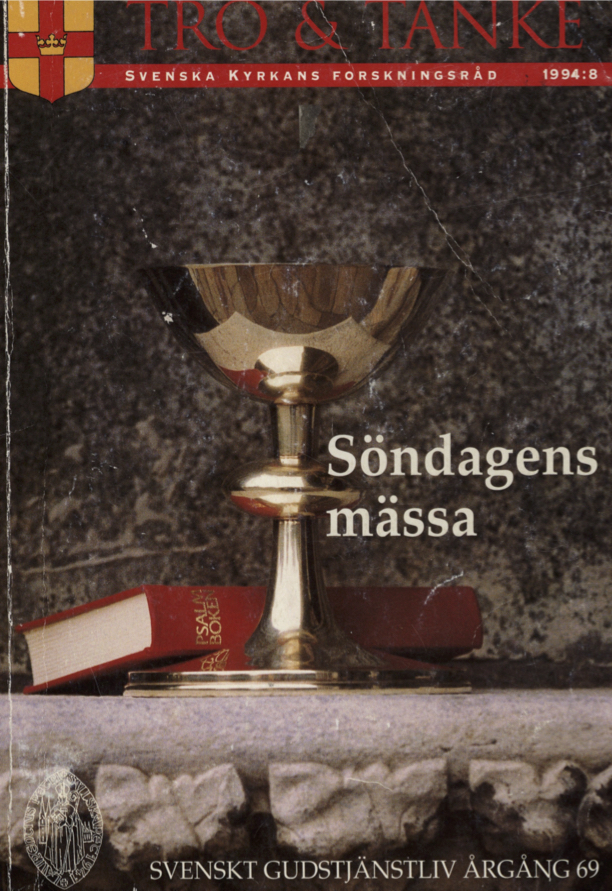Om den söndagliga mässan i Svenska kyrkan
Abstract
"The communion statistics is the great exception of the statistical data in the church." At the beginning of this century the Eucharist was a rare event in most parishes in the Church of Sweden. The contrast is obvious compared with the situation of today. This article focuses on the Eucharist in the Sunday main services in the Church of Sweden. On average, there was communion one Sunday out of three in 1992. While the numbers of churchgoers of all categories are decreasing, the number of communions and the frequency of communicates are increasing. It has been like this for a long time, and especially since the early 60’s.
What has caused this process of change? The author formulates a number of explanatory models. They are seen as interacting factors in a very complicated process of profound transformation. Partly, they are seen in a chronological framework. The models stress the following factors.
a. The high-church movement in the Church of Sweden with strong emphasis on the restauration of the every-Sunday High mass in the local church.
b. The experience of the Eucharistic celebration in the Life and Work conference held in Stockholm in 1925 is taken as an example of the important influence of emotional experience on the cognitive process. In the early decades of the 20th century, big meetings grew common, for youths and others, where the Eucharist was celebrated.
c. The third model is founded on changes in the history of ideas in the cultural framework. This caused an alteration of Swedish theology in the 1930’s. The message was a clearly-defined Christianity and a church sharply marked off from the world. As a result of this high-profiled theology the Eucharist, as the specific Christian contribution to the service, got increased importance.
d. The ecumenical contacts during this century have had important influences on the Church of Sweden. During the life and work of Yngve Brilioth impulses came from the Anglican Church. The relationship be tween the Church of Sweden and the Anglican Church has been characterized as a general frame of reference in the first part of the 20th century. The biblical/exegetical movement with its stress on the new under standing of the church and the sacraments has been important, together with the liturgical movement (Dorn Gregory Dix and the second Vatican Council). One important ecumenical contribution to Swedish church life is the widening of the Eucharistie understanding. The earlier under standing was above all focused on repentance and atonement. Nowadays, the Eucharistie understanding includes the Eucharistie rejoice, the sacrifice, the commemoration, the communion, the social implications of the Eucharist, etc.
e. Also the attitude towards the Eucharist and towards the participants in the Eucharist has changed. The emphasis vis-å-vis the communicater was earlier on the Christian discipline but is now on pastoral care.
f. Our way of understanding the Eucharist is influenced by how we celebrate it. The liturgical agendas from 1942 and 1986 are important mile stones in the Church of Sweden and its liturgical improvement. The liturgical settings are largely dependent on the international liturgical impulses. This also includes church architecture.
g. After the Second World War, town-planning as well as pastoral planning has identified mans need of community. The Eucharist as a concrete community-act is able to meet this human need. The Eucharis tie act also serves as a corrective against a two-room thinking where heaven is separated from earth and faith from deed.
What will the future look like, concerning the Eucharistie celebration in Sunday main services? There seems to be a widespread point of view that modern man is not prepared to accept a closed system of religion or ideology. Rather he picks something here and something there and, so-to- say, packs his own basket of an outlook on life. W hen he joins in the service, he hears what he wants to hear. He is not interested in listening and analyzing, but in taking an active part and making experiences (learning- by-action). A hypothesis is formulated: the sacramental realism in the Eucharist has the necessary requirements to answer in a more adequate way the need of wholeness and total communication by post-secularized or post-modern man than has verbal communication.
The described process of change is characterized as a deep-going pro cess with several interacting factors. It is not probable that this process will be interruppted suddenly. The consequence is that the number of Eucharistic celebrations connected with the Sunday main services will still be increasing. It is likely that the Eucharist will more and more be the central liturgical act in the Church of Sweden.
Downloads
Published
Issue
Section
License
© the authors, Laurentius Petri Sällskapet för Svenskt Gudstjänstliv and Artos & Norma Bokförlag. Copying and using material from Svenskt Gudstjänstliv for scholarly purposes is permitted as long as the source is indicated. For other uses, please contact the respective author as well as the publisher. Special restrictions may apply to images.


